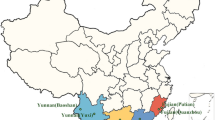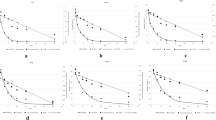Abstract
Methomyl, S-methyl (EZ)-N-(methylcarbamoyloxy)thioacetimidate, is a systemic insecticide chosen for the management of shoot and fruit borer, Leucinodes orbonalis G. Codex Alimentarious Commission has proposed a maximum residue limit (MRL) of 0.2 mg kg − 1 of methomyl, and there is a need to validate this value on eggplant. First + first-order model can explain the nonlinear dissipation pattern of methomyl conveniently in comparison to first-order kinetics. The preharvest intervals (PHI) of 27.3 and 35.3 days as obtained from first + first-order model for single and double doses would bring down the methomyl residue below MRL in actual practice. The respective half-lives were 6.6 and 7.8 days. On the other hand, first-order model suggests methomyl dissipated with a half-life value around 5 days and proposed PHIs of 6.57 and 8.57 days for single and double doses, which was far from reality. Hence, five different decontamination agents were chosen for the decontamination of methomyl from eggplant. Safety factors such as theoretical maximum daily intake and maximum permissible intake were used to evaluate risk assessment to human health. A 3-day waiting period for the both doses, following conventional agricultural practice and processing factor could not ensure sufficient margin of safety. Subjecting the data to a processing factor of 60% could not bring the residues below the proposed MRL by Codex. Methomyl is not found appropriate and effective for application in eggplant. Either the proposed MRL needs to be revised or good agricultural practice involving methomyl for plant protection in eggplant cultivation is questioned.
Similar content being viewed by others
References
Aktar, M. W., Sengupta, D., & Chowdhury, A. (2008). Degradation dynamics and persistence of quinalphos and methomyl in/on okra (Ablemoschus esculentus) fruits and cropped soil. Bulletin of Environmental Contamination and Toxicology, 80, 74–77.
American Crop Protection Association (1995). Pesticides production: Total gained in 1993, despite fungicides decline. Chemical Engineering News, 73(66), 44, 3–4.
Banerjee, K., Oulkar, D. P., Patil, S. H., Dasgupta, S., & Adsule, P. G. (2008). Degradation kinetics and safety evaluation of tetraconazole and difenoconazole residues in grape. Pest Managment Science, 64, 283–289.
Baron, R. L. (1991). Carbamate insecticides. In W. J. Hayes Jr., & E. R. Laws (Eds.), Handbook of pesticide toxicology (pp. 3–6). New York: Academic.
Chadha, K. L., & Shikhamany, S. D. (1999). The grape—improvement, production and post-harvest management (pp. 419–421). New Delhi: Malhotra.
EPA (USA) (2008). Table 40 – Protection of Environment, Chapter 1 – Environment Protection Agency. Part 180 – Tolerances and Exemptions from Tolerances for 15 Pesticide chemicals in food, pp. 511. http://www.epa.gov/EPA-PEST/2003/September/Day-26/p24371.htm. Accessed 23 September 2008.
European Union, Commission Directorate of General Health and Consumer Protection (2000). Guidance document on residue analytical methods, SANCO/ 825/00 rev. 6, 20 June 2000. http://www.ec.europa.eu/food/plant/protection/resources/guide_doc_825-00_rev7_en.pdf. Accessed 28 Dec 2007.
FAO (2006). Recommended maximum residue levels, STMR and HR values and established ADI and ARfD values, Rome, 3–12 October. http://www.fao.org/ag/AGP/AGPP/Pesticid/JMPR/Download/2006AnnexIFinal.pdf. Accessed 7 Apr 2008.
Fukuto, R. T. (1987). Organophosphates and carbamate esters: The anticholinesterase insecticides. In J. W. Biggar, & J. N. Silber (Eds.), Fate of pesticides in the environment, publication number 3320, (pp. 3–2). Davis: University of California Agricultural Experiment Station.
Gopal, M., Niwas, R., & Gaur, A. (2006). A process for the decontamination of vitavax residues from wheat seed. Indian Patent Application Number 2217/DEL filed on 9.10.2006.
Horwitz, W., & Albert, R. (2006). The Horwitz ratio (HorRat): A useful index of method performance with respect to precision. Journal of AOAC International, 89, 1095–1109.
Hoskins, W. M. (1961). Mathematical treatment of the rate of loss of pesticide residue. FAO Plant Protection Bulletin, 9, 163–168.
Jayakrishnan, S. (2005). Evaluation of pesticide residues on eggplant, Solanum melongena L. subjected to plant protection measures for control of shoot and fruit borer, Leucinodes orbonalis Guen. Ph.D. thesis, P.G. School, IARI, New Delhi, India.
Kidd, H., & James, D. R. (Eds.) (1991). The agrochemicals handbook, (3rd ed., pp. 3–11). Cambridge: Royal Society of Chemistry Information Services.
Mukherjee, M., & Gopal, M. (1992). Residue behaviour of fenvalerate, tau-fluvalinate, lambda-cyhalothrin and monocrotophos in eggplant (Solanum melongena L.) Fruits. Pesticide Science, 36, 175–179.
OriginPro 7.5 SR0 v7.5714 (2003). OriginLab Corporation, One Round House Plaza, Northampton, MA01060, USA.
Oulka, D. P., Banerjee, K., Patil, S. H., Upadhyay, A. K., Taware, P. B., Deshmukh, M. B., et al. (2009). Degradation kinetics and safety evaluation of buprofezin residues in grape (Vitis vinifera L.) and three different soils of India. Pest Managment Science, 65, 183–188. http://www.interscience.com. doi:10.1002/ps.1666.
Premalatha, R., Kuttalam, S., Jayakumar, R., Chandrasekaran, S., & Nalini, T. (2003). Residues of methomyl in cotton seed, lint and oil. Pesticide Research Journal, 15(1), 55–57.
Regupathy, A., Palanichamy, S., Chandramohan, N., & Gunathilakaraj, K. A. (1989). Guide on crop pests (p. 276). Coimbatore: Department of Agricultural Entomology, Centre for Plant Protection Studies, Tamil Nadu Agricultural University.
Sardana, H. R., Trivedi, T. P., Bambawala, O., Sabir, N., Singh, R. V., Arora, S., et al. (2004). Vegetable crops. In A. Singh, H. R. Sardana, & N. Sabir (Eds.), Validated IPM technologies for selected crops (p. 127). New Delhi: National Centre for Integrated Pest Management.
Sinha, S., & Gopal, M. (2002). Evaluating the safety of beta-cyfluthrin insecticide for usage in eggplant (Solanum melongena L.) crop. Bulletin of Environmental Contamination and Toxicology, 68, 400–405.
Stevens, J. T., & Sumner, D. D. (1991). Herbicides. In W. J. Hayes, Jr., & E. R. Laws, Jr. (Eds.), Handbook of pesticide toxicology (pp. 3–5). New York: Academic.
Subbian, P., Annadurai, K., & Palaniappan, S. P. (2000). Agriculture, facts and figures (p. 216). New Delhi: Kalyani.
Ware, G. W. (1986). Fundamentals of pesticides, a self-instruction guide (p. 3–3). Fresno: Thompson.
World Health Organization (2007). Guidelines for predicting dietary intake of pesticide residues (revised). Global Environment Monitoring System—Food Contamination Monitoring and Assessment Programme GEMS/Food) in collaboration with the Codex Committee on Pesticide Residues. Programme of Food Safety and Food Aid. Geneva: World Health Organization.
Author information
Authors and Affiliations
Corresponding author
Rights and permissions
About this article
Cite this article
Aktar, M.W., Sengupta, D., Alam, S. et al. Risk assessment and chemical decontamination of an oxime carbamate insecticide (methomyl) from eggplant, Solanum melongena L.. Environ Monit Assess 168, 657–668 (2010). https://doi.org/10.1007/s10661-009-1141-0
Received:
Accepted:
Published:
Issue Date:
DOI: https://doi.org/10.1007/s10661-009-1141-0




